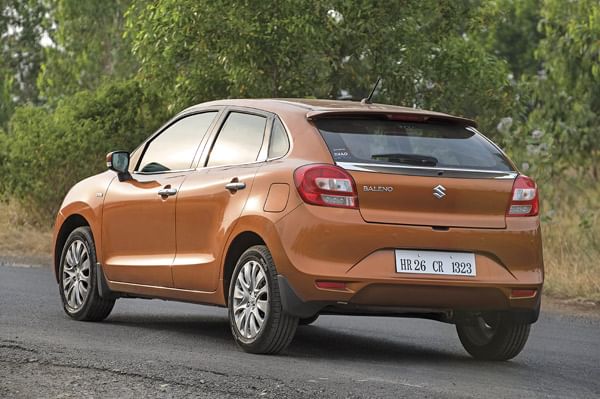2015 Maruti Baleno review, road test
Read the 2015 Maruti Baleno review, road test from Autocar India; Maruti's largest hatchback yet has large aspirations. Does it deliver?
Published on Dec 17, 2015 07:00:00 AM
1,90,954 Views
Follow us on


Maruti’s new ‘liquid flow’ design language is full of curves and very few angles.

All black Interiors lack premium feel but V-shaped centre console livens things up.
The Baleno is powered by a familiar range of powertrains commonly found under the hood of several other Marutis. It’s the CVT transmission in the Baleno automatic that’s new. Interestingly, Maruti decided against Automated Manual Transmission (AMT), the trend in small cars these days. This is because AMTs carry a bit of a stigma as being a ‘poor man’s automatic’, something Maruti consciously wants to avoid, given the Baleno’s position as a premium hatch.
The 1.2-litre K12 petrol motor is one of our favourites and a reminder that Suzuki makes some of the best small displacement petrol engines. In the lightweight Baleno, the K12’s peppy character is further amplified and this is immediately apparent the moment you slot the smooth-shifting gear lever into first and engage the clutch. The Baleno takes off with an urgency not seen in any other hatchback and sprints to 100kph in a brisk 12.60 seconds. There’s no drastic let up in pace, and on our test trip, we hit 140kph in 25.67 seconds, which is 8.34 seconds faster than the heavier Swift. The best bit is that this superbly balanced motor absolutely loves being revved without feeling strained. There’s a fair bit of mechanical noise at high revs, but it’s more a result of skimpy sound insulation (to save weight) than engine harshness. It’s a pity then that the rev limiter has been set at a conservative 6,200rpm. This engine could easily spin faster.
Superb part-throttle response makes the Baleno well-suited to darting through traffic. A mere prod of the throttle allows you to close gaps with ease. Press down further and you encounter the engine’s unenthusiastic and flat mid-range and this is most evident when you’re trying to overtake in the rather tall third gear. You often need to downshift and rev the motor if you’re in a hurry.
Another issue is that bit of hesitation or jerkiness at low revs and in stop-go traffic, which we put down to the ECU mapping. We feel Maruti engineers, while tuning the ECU, have compromised a seamless power delivery for class-best fuel efficiency.
| Maruti Suzuki Baleno Price, Mileage, Specifications, Features and Variants | |
|---|---|
| Brand | Maruti Suzuki |
| Model Name | Baleno |
| Maruti Suzuki Baleno Price | ₹ 7.62 - 11.21 lakh |
| Maruti Suzuki Baleno Range/Mileage | Petrol : 22.35 - 22.94kpl |
| Maruti Suzuki Baleno Specifications | Hatchback | 5 doors | 5 seats View All Specs |
| Maruti Suzuki Baleno Features | LED headlight | 9-inch Touchscreen display | 6 airbags View All Features |
| Maruti Suzuki Baleno Variants | 1.2 Petrol Sigma MT | 1.2 Petrol Delta MT | 1.2 Petrol Delta AMT View All Variants |
The CVT in the Baleno automatic is responsive at low speeds, maybe too responsive, and modulating the throttle in traffic snarls requires an initial getting used to. On the highway, however, the CVT quickly loses its appeal. Because of the way it holds a constant engine speed, there’s a continuous drone, which can get quite irritating. Toggle the Sport button on the gear lever and you can feel the CVT acting faster, but on the highway, it doesn’t have much of an effect.
Enthusiasts may be disappointed that the Baleno gets the ubiquitous Fiat-sourced 1.3 diesel with the lower power output. Badged the DDiS 190, this 74bhp engine is not as under-powered as you’d think. Again, it’s all about power-to-weight ratio and the bantam Baleno diesel is no slouch. The 0-100kph is dispatched in 12.92 seconds, but it’s the punchy mid-range that’s most potent. Drop below 1,900rpm and the Baleno engine gets bogged down. There’s a fair bit of turbo lag, inherent in small displacement diesel engines, and if you’re in a hurry, you have to constantly use the five-speed ’box to stay in the meat of the powerband.
The DDiS motor revs quite easily to 5,000rpm, which is high for a diesel, but it’s best to upshift just after the 4,000rpm mark. At high revs, the engine feels harsh and noisy and you can’t escape that diesel drone. Refinement is quite poor and we find that this ageing Fiat diesel is getting outclassed by bigger displacement diesels now in most areas.
Copyright (c) Autocar India. All rights reserved.





Comments
Member Login
Personal Details
No comments yet. Be the first to comment.